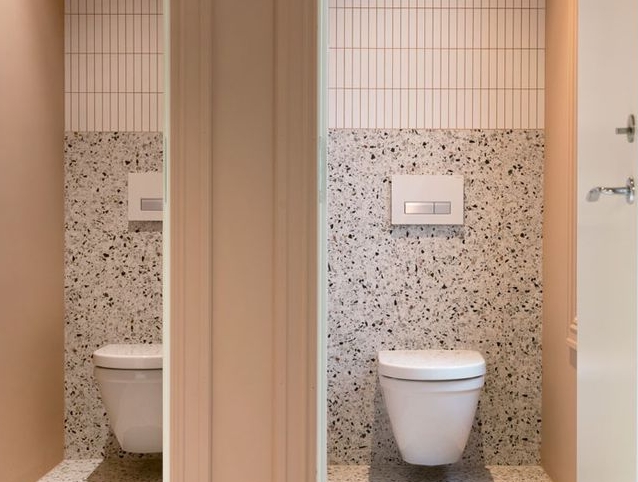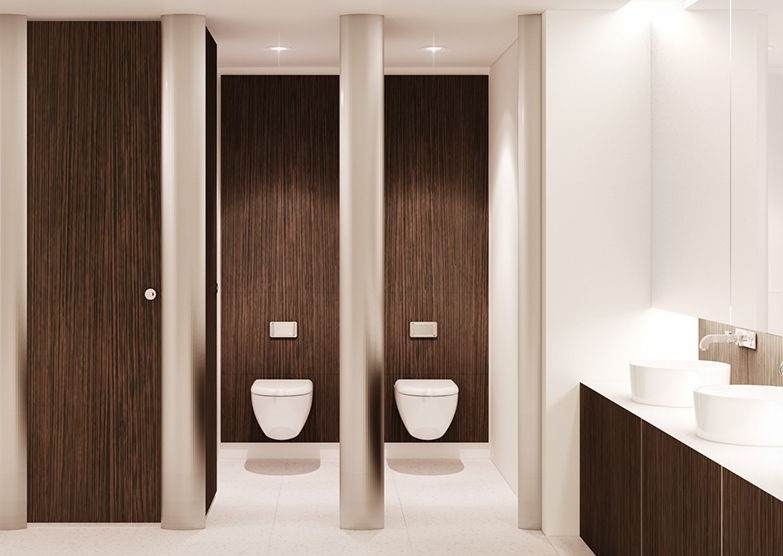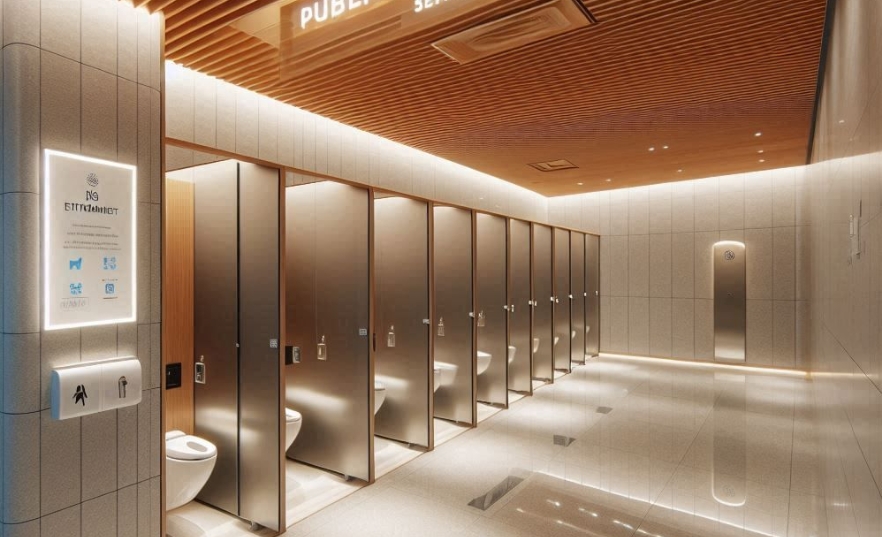When deciding between wall-hung and floor-mounted commercial toilets for your business, various factors merit careful consideration. Each option presents unique advantages and potential drawbacks. Wall-hung toilets, with their sleek design and space-saving benefits, can enhance modern aesthetics and ease of cleaning, whereas floor-mounted models offer straightforward installation and lower initial costs. However, the choice extends beyond mere appearance and price. How do these options align with long-term maintenance needs and compliance with accessibility standards? These considerations could greatly impact your operational efficiency and customer satisfaction. What essential elements should influence your decision-making process?

image from Pinterest
When considering the installation of wall-hung versus floor-mounted toilets, it is crucial to frequently evaluate the structural requirements and cost implications of each option.
Wall-hung toilets, with their modern design, demand a robust support system within the wall, often necessitating reinforced walls or a steel frame to manage their weight and plumbing requirements. This can escalate installation complexity, requiring precise coordination with structural engineers and plumbing specialists. Consequently, the initial costs may be higher due to these additional structural modifications and the specialized skills needed.
Conversely, floor-mounted toilets typically present fewer plumbing requirements and installation challenges, as they rely on the existing floor plumbing system. This simplicity in design can lead to lower upfront installation costs, making them an appealing choice for businesses seeking cost-effective solutions.
However, the decision should be carefully balanced with the desired aesthetic and spatial considerations.
For businesses aiming to maintain control over budget and installation timelines, it is vital to conduct a thorough cost-benefit analysis. Evaluating the long-term benefits and potential return on investment of each option will guarantee that the chosen toilet type aligns with the business's operational and financial objectives.
When evaluating the maintenance and cleaning aspects of wall-hung versus floor-mounted toilets, accessibility and ease of cleaning are essential considerations.
Wall-hung toilets offer a significant advantage in reducing cleaning time and effort due to their elevated design, which allows for easier access beneath the toilet and eliminates hard-to-reach floor crevices.
Conversely, floor-mounted toilets may require more frequent and intensive cleaning efforts, impacting long-term maintenance costs and scheduling.
In the domain of toilet design, the choice between wall-hung and floor-mounted models greatly impacts maintenance and cleaning accessibility. Wall-hung toilets provide superior user experience and design flexibility by offering clear access to the floor beneath. This accessibility not only facilitates easier cleaning but also greatly reduces the risk of bacterial accumulation, enhancing the overall hygiene of your commercial space.
The absence of a base on the floor means that maintenance staff can swiftly perform their duties, optimizing cleaning schedules and reducing labor costs.
Conversely, floor-mounted toilets, while traditionally robust, present challenges regarding maintenance accessibility. The base, which is in constant contact with the floor, can become a hotspot for grime and bacteria, necessitating more frequent and intensive cleaning efforts.
Additionally, the design limits access, potentially increasing cleaning time and operational costs.
From a cost analysis perspective, initial installation of wall-hung toilets might require higher investment due to the need for reinforced walls and specialized mounting systems. However, businesses may find long-term savings in reduced maintenance and cleaning labor.
Installation guidance suggests that opting for wall-hung models could yield considerable control over cleanliness, ultimately enhancing the operational efficiency of commercial restrooms.
Significant reductions in cleaning time can be achieved by opting for wall-hung toilets in commercial settings.
These toilets simplify maintenance and cleaning processes by eliminating the hard-to-reach areas associated with floor-mounted models. The streamlined design allows for greater access underneath the unit, facilitating quicker and more efficient cleaning.
Here are several reasons why wall-hung toilets enhance time efficiency and reduce the need for extensive cleaning products:
In the context of maximizing restroom space, wall-hung toilets offer a significant advantage due to their compact design, which facilitates efficient layout planning.
By mounting the toilet on the wall, floor space is freed up, allowing for greater flexibility in small or uniquely shaped bathrooms.
While the initial installation costs for wall-hung models may be higher, the long-term benefits of enhanced space utilization often justify the investment.

image from Pinterest
Space optimization in modern restroom design demands a strategic approach to fixture selection, particularly when comparing wall-hung and floor-mounted toilets.
Wall-hung toilets offer significant advantages in maximizing restroom space, enhancing both restroom comfort and user experience. These units are mounted directly onto the wall, allowing for increased floor area and a cleaner aesthetic, which can contribute to a more spacious feel.
To effectively maximize restroom space, consider the following factors:
An efficient layout planning approach in restroom design hinges on strategic space utilization, which can greatly impact both functionality and aesthetics. When selecting between wall-hung and floor-mounted toilets, space utilization should be a primary consideration, as it directly influences user experience and customer satisfaction.
Wall-hung toilets offer a sleek design with the cistern concealed within the wall, freeing up floor space and presenting a modern, uncluttered appearance. This design not only enhances the visual appeal but also allows for easier cleaning and maintenance, reducing long-term operational costs.
In contrast, floor-mounted toilets, while often more traditional in appearance, require a larger footprint due to their direct installation on the floor. This can limit the flexibility of restroom layout and potentially diminish user experience if space is constrained.
From a cost analysis perspective, wall-hung toilets may incur higher initial installation costs due to the complexity of wall mounting and plumbing adjustments. However, the investment can be offset by the enhanced customer satisfaction and efficient space utilization they provide.
Ultimately, the choice between these options should be guided by a thorough understanding of the specific spatial dynamics of your commercial restroom and the priorities of your business.
Maximizing restroom efficiency often hinges on the compact design benefits that wall-hung toilets provide, primarily through ideal space utilization. The strategic decision to incorporate wall-hung toilets in commercial settings offers numerous advantages that appeal to businesses seeking superior control over their restroom environments.
These units are engineered for design flexibility, allowing for an enhanced user experience while maximizing the available square footage.
When evaluating the financial implications of choosing between wall-hung and floor-mounted toilets, it is essential to take into account both initial purchase costs and long-term expenses.
Wall-hung toilets typically require a higher initial investment due to the need for specialized mounting hardware and potential structural modifications to accommodate in-wall cisterns. In contrast, floor-mounted toilets generally entail lower upfront costs, as they are easier to install with standard plumbing connections and require no additional support structures.
However, long-term savings should not be overlooked. Wall-hung toilets often result in reduced maintenance costs in commercial settings because their design allows for easier cleaning beneath the unit, potentially minimizing labor and cleaning expenses.
Additionally, their water-saving flushing mechanisms can lead to significant utility savings over time. Floor-mounted toilets, while potentially more affordable initially, may incur higher maintenance costs due to the more challenging cleaning process around their base and the possibility of more frequent repairs or replacements.

image from Pinterest
Beyond the financial considerations, the aesthetic appeal of wall-hung versus floor-mounted toilets plays a significant role in the decision-making process. An understanding of design styles and color options is essential for businesses seeking to create an inviting and modern restroom environment.
Wall-hung toilets often present a sleek, minimalist appearance, allowing for varied customization with contemporary design styles. Conversely, floor-mounted toilets may offer a more traditional look, but can be integrated seamlessly into a wide array of settings.
When evaluating aesthetic appeal, consider the following factors:
Selecting the appropriate toilet style is vital to aligning with your business's overall aesthetic vision.
Looking to elevate your restroom design?
Browse our commercial toilets — sleek, space-saving, and crafted to complement modern interiors without compromising performance.
How do wall-hung and floor-mounted toilets compare regarding durability and longevity? The answer largely depends on material selection and installation quality.
Wall-hung toilets, typically supported by a robust steel frame, require precise installation to guarantee long-term stability. The concealed tank and carrier system are critical components that must be properly secured within the wall. These toilets often use high-quality ceramics and stainless steel, contributing to their longevity. However, their durability can be compromised if improper materials are used or if the installation is not up to standard.
Conversely, floor-mounted toilets have the advantage of a simpler installation process, reducing the risk of errors that could affect durability. They rely on a direct connection to the floor, often using heavy-duty ceramics designed to withstand frequent use in commercial settings.
Their simpler design means fewer components are susceptible to failure, thus potentially extending their lifespan.
User preference plays a role in determining the best option for a business. While wall-hung toilets offer a modern aesthetic, they require careful consideration of installation and material quality.
Floor-mounted toilets, while less visually appealing, provide a time-tested solution with reliable durability and longevity.
In addressing accessibility and compliance, it is essential to evaluate both wall-hung and floor-mounted toilets in the context of regulatory standards such as the Americans with Disabilities Act (ADA). This analysis not only guarantees legal compliance but also enhances user experience through universal design.
Here are key considerations:
Ultimately, selecting the appropriate toilet type requires a balance between initial costs, installation complexities, and ongoing compliance benefits.
Wall hung toilets can reduce noise levels in commercial settings by isolating vibrations. However, installation challenges and maintenance requirements may offset these benefits, necessitating technical expertise and cost analysis to guarantee ideal installation guidance and long-term efficiency.
Wall hung toilets boast an impressive weight capacity of up to 500 pounds, contingent on precise installation requirements. With expert installation guidance and cost analysis, these fixtures guarantee robust performance, catering to specific needs of discerning commercial establishments.
For wall hung toilets, brand comparisons reveal that Geberit, Kohler, and Toto are highly regarded for quality. Installation considerations include compatibility with existing plumbing and structural support, influencing costs. These factors guide informed decisions for businesses prioritizing functionality and value.
Floor-mounted toilets generally offer reliable water conservation in high-traffic areas by utilizing efficient flushing systems. However, they may incur higher maintenance costs due to wear and tear, making a cost analysis essential for optimizing installation and long-term operational efficiency.
Like a strategic blueprint, evaluating the environmental impacts of wall-hung and floor-mounted toilets involves weighing sustainability benefits against installation considerations. Wall-hung models typically offer better water efficiency, while floor-mounted ones may be less complex and costly to install.
In the assessment of wall-hung versus floor-mounted commercial toilets, a nuanced approach reveals distinct advantages and considerations. Wall-hung toilets, with their sophisticated design and space-saving capabilities, demand a more substantial initial investment and intricate installation. Conversely, floor-mounted options offer ease of installation and reduced initial expenditure, albeit with potential for greater maintenance over time. The decision should delicately balance aesthetic aspirations and fiscal prudence with operational demands, ensuring the chosen option harmonizes with both spatial constraints and budgetary frameworks.